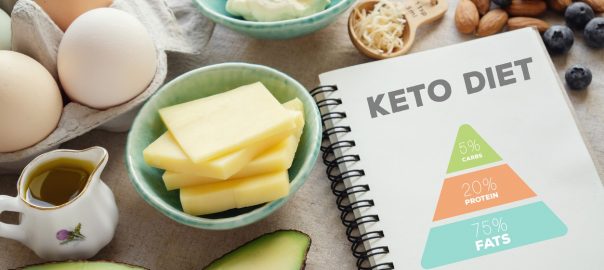
Keto Diet Best Practices
Tips & Suggestions for Healthy Keto Dieting
Follow these 5 new tips to make the most of your ketogenic diet for weight loss and overall improved health.
Given its recent widespread popularity, the ketogenic diet can often get a little bit lost in translation. Many sources encourage practices that are not actually beneficial for your health and may instead lead you astray. In this article, we have laid out some of the best practices to follow if you are currently on or thinking of starting a ketogenic diet. These tips are meant to ensure that you stay healthy while following a low carb, high fat diet and achieve any weight loss goals that you have set for yourself with the greatest ease and success, and avoid common mistakes with the keto diet.
- Avoid processed meats.
It can be misleading that the ketogenic diet, or keto diet, is some sort of free pass to eat loads of bacon, sausages and other indulgent processed meats. However, we cannot stress enough how important it is to choose high quality sources of protein. The health risks associated with consuming a lot of processed meats are too high to be ignored. Clogged arteries, hormonal imbalances, increased risk of chronic diseases, poor mood and premature aging are just a few to mention.
For the keto diet to effectively help with weight-loss, increased energy and improved health, we recommend eating high quality sources of protein such as organic farm-raised turkey or chicken, sustainably caught fish and seafood, pasture-raised eggs and full fat dairy (low fat versions undergo unnecessary processing). Plant-based proteins are also very welcoming to the keto diet and introduce other health benefits such as healthy fats and important nutrients that can only come from plants. We recommend including tofu or tempeh in your diet for high quality proteins with the bonus of being low calorie and low carb. You can also try to include more nuts and seeds into your diet to gain healthy fats and important nutrients directly from these plant sources.
The problem with processed meats is that they are usually made from commercially farmed animals that are fed poor diets and placed under high amounts of stress, which significantly lowers the quality and nutritional value of the meat. Unfortunately, the truth is that no processed foods are healthy to consume, regardless if you follow a ketogenic diet or not.
A simple rule of thumb is to recommend meat that is farm-raised, wild-caught and/or organic. While these choices usually come with a higher price tag, they are well worth the extra cost. Not only are these types of meat better for you and the environment, but purchasing them over processed meats can also discourage harmful farming practices.
As another general guideline, the smaller the animal, the better it is for us to consume. Meat from larger animals, such as cows, contains higher levels of hormones naturally produced by the animal. Anything labelled as “hormone-free” is just a clever marketing ploy. Regulatory bodies have banned hormone injections in most parts of North America, which is great, but these animals still produce their own hormones naturally, just like us. Consuming high amounts of animal hormones can result in our own hormonal imbalances, increased risk of cancer and other diseases, and issues with our reproductive health.
- Track your macros.
If you want to see the best results from your ketogenic diet, you should try tracking your macronutrient intake from the get-go. This means keeping track of your protein, fats and carbohydrates to ensure you are eating the necessary amounts of each to remain in ketosis.
There are plenty of apps out there that tell you the macronutrient breakdown of your food and allow you to record your daily meals. It may also be useful to invest in a kitchen scale for measuring foods that are not pre-measured or portioned. The whole process of tracking your macronutrients may seem time consuming and tedious at first, but it is really the most effective way to make sure you are staying in ketosis. You can also try our at-home ketone tests like these Keto Strips for Urinalysis.
If you don’t know how the exact portion of each macronutrient you should be consuming to achieve and stay in ketosis, consult your physician for an individualized answer. Not everyone will require the same amounts of each of protein, fat and carbohydrates although general guidelines state the following for a ketogenic diet:
Fat – 70%+ of daily calories
Protein – 20-30% of daily calories
Carbohydrates – 5-10% of daily calories
Based on a 2,000 calorie diet, you might consume 1,400 calories from fat, 400-600 calories from protein and 100-200 calories from carbohydrates. Note that fatty foods tend to be more calorically dense, so while this may seem like a lot to consume in terms of calories, it could actually be less than you think in terms of grams (g) or the amount of food.
A Note on Weight Loss
If your goal is to lose weight with the keto diet, keep in mind that you should still aim to be in a caloric deficit. This means that you should consume less calories than your body naturally burns throughout the day. Everyone has their own unique Basal Metabolic Rate (BMR), which is the amount of energy (calories) that our body requires to perform vital functions while at rest (respiration, digestion, cellular repair, etc.). This, plus any calories used for physical activities will make up the total amount of calories you burn in one day. You can find online BMR calculators to help you get a feel of how much you should eat in a day, depending on your weight loss goals. Also, consider reading our article: How Our Bodies Burn Calories.
- Eat home cooked meals as often as possible.
It goes without saying that cooking your own meals is by far the easiest to track and control what you are putting into your body. This is especially important on a diet as strict as the ketogenic diet, since even going slightly over your daily allowable carbohydrate intake could throw you out of ketosis and hinder or delay your weight loss goals.
And although store-bought foods are best for tracking and progress, there are still ways to maintain a keto diet while eating out, the trade off is control. You may not know every ingredient that’s going into your food at a restaurant and although certain packaged foods may appear to fit the requirements of a low carb, high fat diet, they may contain additives and other commercial ingredients that lack nutritional value. The best thing to do is to check the menu online before going out, so you can plan what you’re going to order and any questions you may have about a dish.
The best – and cheapest – way to eat is to follow a whole foods diet by cooking at home. By this we mean purchasing fresh, raw produce and proteins and preparing them yourself with healthy cooking oils and seasonings. This not only makes it easier to count your macros, but it also allows you to control exactly what goes into your food and customize it to your own taste preferences. See our inventory of low carb cooking and baking ingredients that can help making low carb homemade meals a lot easier.
- Don’t forget about fibre!
When we talk about macronutrients, we are usually referring to protein, fat and carbohydrates. On a keto diet, we are mostly concerned with our intake of fats and limiting or eliminating carbs in order to stay in ketosis. That said, there is one very important type of carbohydrate that a lot of keto dieters can forget about; and that is fibre!
Fibre does not count towards net carbohydrates, so it is safe – and necessary – to consume on a ketogenic diet. When reading nutrition facts tables, you can subtract fibre and sugar alcohols from the total carbohydrates to find the net carbs (i.e. the ones that will actually affect your ability to stay in ketosis).
Fibre is an essential part of any diet; it helps regulate digestion, keeps us full, and fibrous foods such as vegetables and fruits supplement the diet with essential nutrients for our bodies to function and thrive.
Always opt for whole food sources of fibre, such as raw or steamed cruciferous vegetables and leafy greens rather than fibre supplements. The bulk and roughage provided by actual plant matter is very beneficial for the body. One great way to increase your fibre intake is to leave the skins on your vegetables which contain high amounts of insoluble fibre (plus, this means less prep time in the kitchen!).
Here are some low carb vegetables that provide dietary fibre:
- Cauliflower
- Broccoli
- Brussels sprouts
- Cabbage
- Kale
- Spinach
- Beet greens
- Celery
- Cucumber
- Bok choy
- Asparagus
- Zucchini
- Artichokes
Unsure how to incorporate these into your diet in tasty and appealing ways? See these delicious keto-friendly recipes below!
- Low Carb keto Spinach Artichoke Dip try it with these high fibre crispbreads from KZ Clean Eating!
- Miso Salmon with Bok Choy and Asparagus
- Keto Instant Pot Stuffed Cabbage
- Green Shakshuka Breakfast Skillet – use kale, spinach or Swiss chard, or a combination of greens.
- Best Keto Egg Salad – you can swap out the eggs for tuna or cooked chicken! Double up the vegetable portions for extra fibre.
Some other great sources of fibre that are compliant with a low carb or ketogenic diet include:
- Flax seeds (ground for best absorption)
- Chia seeds
- Chicory root (can be found in certain cereals, bars and these sugar-free Smart Sweets gummy candies!)
- Psyllium husk
- Oat fibre
- Plan and be patient.
Weekly meal planning is a great way to minimize a lot of the thought and effort that must go into a ketogenic diet, especially when you are just starting out and getting used to eating the right amounts of each macronutrient. Meal planning can also help you stay on a desired budget and prevent impulse or binge eating when you don’t have anything planned.
Planning can also keep you on track towards your goals. Keep in mind that it takes about 3 months for most people to see noticeable changes in their body, depending on body type and other factors such as your natural metabolic rate and exercise regimens. Many people think that the ketogenic diet can be used to see fast results since it is a drastic lifestyle change, but remember that it also takes time for your body to adjust to this new way of eating and living.
In the beginning, you may get discouraged by common symptoms of a ketogenic diet, such as sugar cravings, nausea, brain fog, insomnia and muscle soreness. Be prepared to experience some or all of these at first, and if they become unbearable speak to a physician to learn the best course of action for you. In general, it is best to ease into the transition to minimize these side effects. This may add a few more weeks to your weight loss plan, but it is well worth it and will ensure the most comfortable transition. Take this time to search for new recipes, put together meal plans and speak to friends or colleagues who have gone through the same changes.
The good news is that many people do see incredible results and health transformations from a ketogenic diet! Our bodies are so versatile in that they can use either carbohydrates or fat as fuel, and for many, a low carb high fat diet can produce miraculous health benefits. For anyone pursuing a ketogenic journey, it does require time, diligence and proper support to see positive results. We are always here to support our customers and answer any questions you may have about our products or the low carb lifestyle. Message us on Facebook, Instagram and visit us in store, or reach us by phone at (888) 484-7479 or email at [email protected]
Let’s get started!
We hope that you enjoyed reading this article and that you were able to find some ideas that you can implement in your keto diet. Be sure to check out all our keto dieting
If you would like to share your thoughts or experiences, head over to our Facebook and Instagram pages. We also love to read and respond to our reviews on Google, so please share your experience with The Low Carb Grocery, there!
Please also consider subscribing to our Weekly Newsletter for updates and sales on our latest products and specials!






